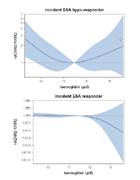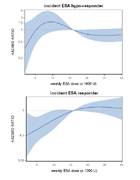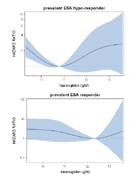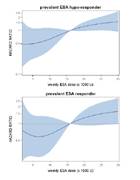A. Kainz(1,2), B. Mayer(3), R. Kramar(4), R. Oberbauer(1,2,4)
1- Department of Nephrology, Medical University of Vienna, Austria
2- Department of Nephrology, KH Elisabethinen, Linz, Austria
3- emergentec Biodevelopment GmbH, 1080 Vienna, Austria
4- Austrian Dialysis and Transplant Registry, Linz, Austria

Association of hemoglobin variability group with mortality in an unadjusted Cox model (reference group MM).
View PDF
Hemoglobin values of patients vs administered ESA dose for each year during followup time
a: first year of treatment
View PDF
Hemoglobin values of patients vs administered ESA dose for each year during followup time
b: second year of treatment
View PDF
Hemoglobin values of patients vs administered ESA dose for each year during followup time
c: third year of treatment
View PDF
Hemoglobin values of patients vs administered ESA dose for each year during followup time
d: fourth year of treatment
View PDF
Association of hemoglobin variability group with mortality. Cox model is adjusted by age, vintage of dialysis, and sex.
View PDF


Association of hemoglobin variability group with mortality. Cox model is adjusted by age, vintage of dialysis, sex, and ESA response group.
View PDF
Dependency of hazard ratio of achieved hemoglobin levels for patients with baseline hemoglobin corresponding to
a: group L
View PDF
Dependency of hazard ratio of achieved hemoglobin levels for patients with baseline hemoglobin corresponding to
b: group M
View PDF
Dependency of hazard ratio of achieved hemoglobin levels for patients with baseline hemoglobin corresponding to
c: group H
View PDF
Association of hemoglobin variability group with mortality. Cox model is adjusted by age, vintage of dialysis, sex, ESA response group, diabetes, and BMI. Missing BMI values were imputed by mulitple imputation through linear regression.
View PDF
Dependency of hazard ratio of ESA dose levels for patients with baseline hemoglobin corresponding to
a: group L
View PDF
Dependency of hazard ratio of ESA dose levels for patients with baseline hemoglobin corresponding to
b: group M
View PDF
Dependency of hazard ratio of ESA dose levels for patients with baseline hemoglobin corresponding to
c: group H
View PDF
Dependency of hazard ratio of ESA dose levels for patients with
a: baseline hemoglobin ≤ 12 g/dl
View PDF
Dependency of hazard ratio of ESA dose levels for patients with
b: baseline hemoglobin > 12 g/dl
View PDF
Dependency of hazard ratio of ESA dose levels for patients with
a: baseline hemoglobin ≤ 12 g/dl
View PDF
Dependency of hazard ratio of ESA dose levels for patients with
b: baseline hemoglobin > 12 g/dl
View PDF
Hazard ratio for haemoglobin levels of incident patients stratified in groups of ESA responsiveness.
View PDF
Hazard ratio for ESA dose of incident patients stratified in groups of ESA responsiveness.
View PDF
Hazard ratio for haemoglobin levels of prevalent patients stratified in groups of ESA responsiveness.
View PDF
Hazard ratio for ESA dose of prevalent patients stratified in groups of ESA responsiveness.
View PDF
